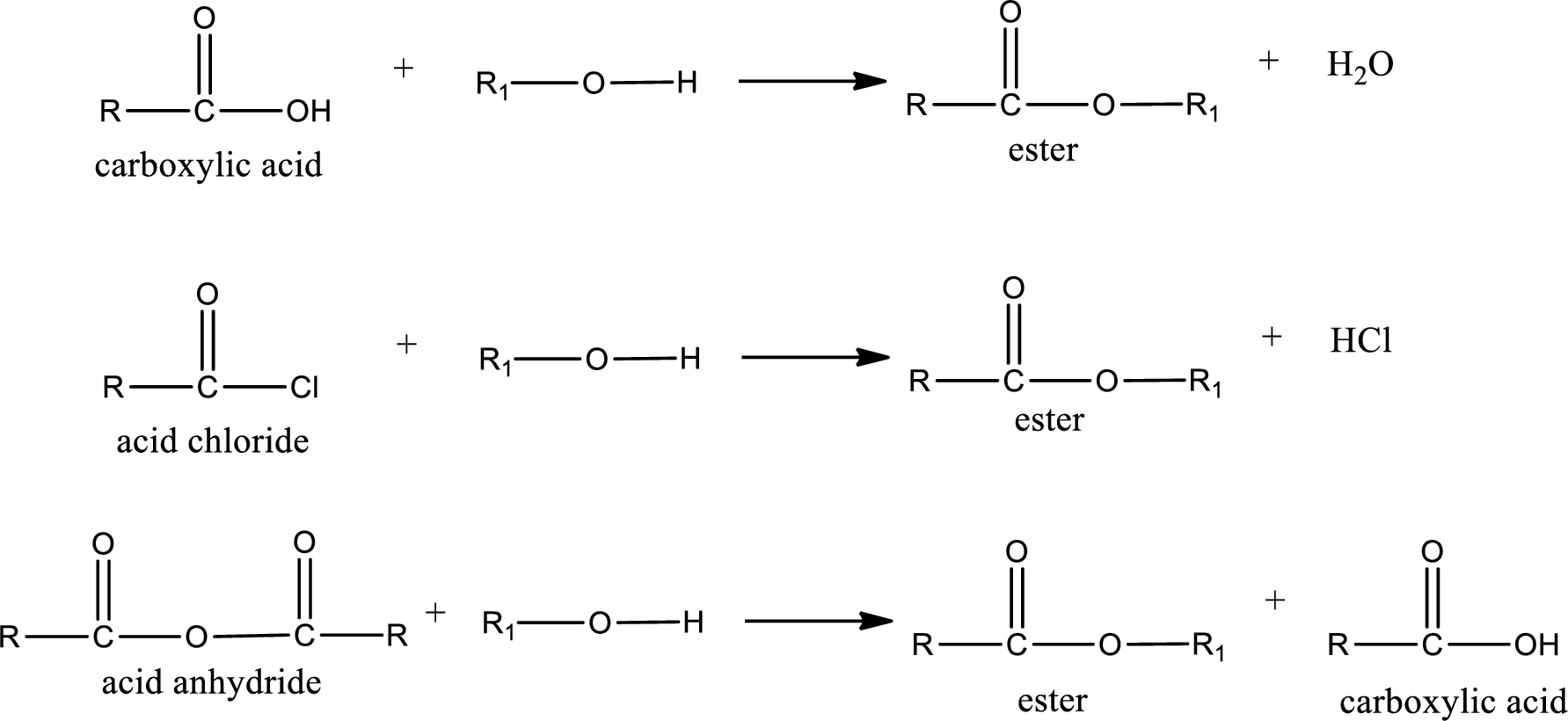
Concept explainers
(a)
Interpretation:
Condensed structural formula of the
Concept Introduction:
Acyl transfer reaction is the one in which the acyl group is transferred from one molecule to another molecule. This reaction occurs very frequently in biological systems. Some of the acyl group containing compounds are carboxylic acid, acid chlorides, acid anhydrides etc. General reaction scheme for acyl transfer reaction can be given as shown below,

(b)
Interpretation:
Condensed structural formula of the carboxylic acid and ester formed when ethanoic anhydride reacts with 2-butanol has to be drawn.
Concept Introduction:
Acyl transfer reaction is the one in which the acyl group is transferred from one molecule to another molecule. This reaction occurs very frequently in biological systems. Some of the acyl group containing compounds are carboxylic acid, acid chlorides, acid anhydrides etc. General reaction scheme for acyl transfer reaction can be given as shown below,

Want to see the full answer?
Check out a sample textbook solution
Chapter 16 Solutions
General, Organic, and Biological Chemistry
- 1. Draw the structural formula of the hemiacetal formed from each ơf the following pairs of reactants. a. Acetaldehyde and methanol 0 b. 2-Pentanone and ethyl alcohol С. Butanal and isopropyl alcohol d. Acetone and ethanolarrow_forwardEsters are formed by the reaction of carboxylic acids and acid in the presence of A. Alkanes B. Alcohols C. Alkenes D. Aldehydes E. Alkynesarrow_forwardFor each of the esters provided, identify the alcohol and the carboxylic acid that reacted. a. methyl propanoate b. ethyl methanoatearrow_forward
- Draw a structural formula for each of the following aldehydes. a. Acetaldehyde b. Butyraldehyde c. Dichloroacetaldehyde d. 2-Methylbenzaldehydearrow_forward4. What product forms in the reaction of one carboxylic acid molecule with an alcohol? A. wax B. fatty acid C. phospholipid D. steroid E. glycerolarrow_forwardAn alcohol can be oxidized to produce an aldehyde or aketone. What aldehyde or ketone is produced by the oxidation of each of the following alcohols?a. 3-Pentanol b. 2-Methyl-2-butanolarrow_forward
- 1. Which of the following structural features is possessed by aldehydes but not ketones? a. At least one hydroxyl group is bonded to the carbonyl carbon atom. b. At least one hydrogen atom is bonded to the carbonyl carbon atom. c. The carbonyl carbon atom is bonded to two other carbon atoms. d. The carbonyl carbon atom is part of a ring structure. 2. What is the IUPAC name of the following compound in the attached photo? a. 3-chloro-4-nitrobenzoic acid b. 2-chloro-4-carboxynitrobenzene c. 2-nitro-5-carboxychlorobenzene d. 2-chloro-1-nitro-4-benzoic acid 3. Which of the following is the correct bond-line structure for CH3C≡C(CH2)2CH(CH3)2? a. Structure I b. Structure II c. Structure III d. Structure IVarrow_forwardFormation of Esters. Odor of ester Chemical Equation:arrow_forwardWhat are the different carboxylic acid derivatives? Describe each. What is the specific characteristics of esters and their importance? Enumerate the importance of esterification process in pharmacy and in medicine.arrow_forward
- 3. Which of the following is an ester? A. Ola B. NH O C. D.arrow_forwardHow can phenol be distinguished from cyclohexanol? O A. solubility in water B. solubility in hydrochloric acid solution C. solubility in sodium bicarbonate solution D. solubility in sodium hydroxide solutionarrow_forwardThe carboxylic acid compound is widely used as an antifungal agent a. oxalic b. benzoic c. salicylic d. aceticarrow_forward
 Introductory Chemistry: An Active Learning Approa...ChemistryISBN:9781305079250Author:Mark S. Cracolice, Ed PetersPublisher:Cengage Learning
Introductory Chemistry: An Active Learning Approa...ChemistryISBN:9781305079250Author:Mark S. Cracolice, Ed PetersPublisher:Cengage Learning Chemistry for Today: General, Organic, and Bioche...ChemistryISBN:9781305960060Author:Spencer L. Seager, Michael R. Slabaugh, Maren S. HansenPublisher:Cengage Learning
Chemistry for Today: General, Organic, and Bioche...ChemistryISBN:9781305960060Author:Spencer L. Seager, Michael R. Slabaugh, Maren S. HansenPublisher:Cengage Learning
 World of Chemistry, 3rd editionChemistryISBN:9781133109655Author:Steven S. Zumdahl, Susan L. Zumdahl, Donald J. DeCostePublisher:Brooks / Cole / Cengage Learning
World of Chemistry, 3rd editionChemistryISBN:9781133109655Author:Steven S. Zumdahl, Susan L. Zumdahl, Donald J. DeCostePublisher:Brooks / Cole / Cengage Learning Chemistry & Chemical ReactivityChemistryISBN:9781337399074Author:John C. Kotz, Paul M. Treichel, John Townsend, David TreichelPublisher:Cengage Learning
Chemistry & Chemical ReactivityChemistryISBN:9781337399074Author:John C. Kotz, Paul M. Treichel, John Townsend, David TreichelPublisher:Cengage Learning Chemistry & Chemical ReactivityChemistryISBN:9781133949640Author:John C. Kotz, Paul M. Treichel, John Townsend, David TreichelPublisher:Cengage Learning
Chemistry & Chemical ReactivityChemistryISBN:9781133949640Author:John C. Kotz, Paul M. Treichel, John Townsend, David TreichelPublisher:Cengage Learning





